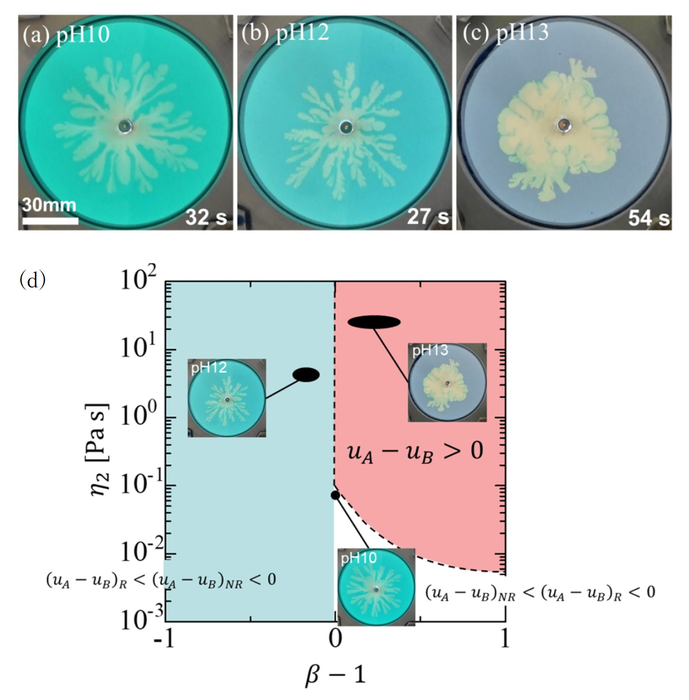Reviewed by Alex SmithMay 11 2022
For the first time, a research group from the Tokyo University of Agriculture and Technology (TUAT) has illustrated, with the help of experiments involving high-precision rheological measurements and a newly proposed theory, that the impact on the flow reverses according to the degree of change in the properties due to the reaction in a reacting flow with the formation of viscoelastic material.
 Figure: (a) ~ (c) Viscous fingering pattern for the gel elasticity is (a) low (b) medium (c) high. (d) Results obtained from stability analysis of flow interface considering viscoelastic properties. In the x-axis, β−1 < 0 or β−1 > 0 means that the gel has shear thinning viscosity or shear thickening viscosity. In the y-axis, η2 > 0 is the shear viscosity of the gel at a certain shear rate. Image Credit: Yuichiro Nagatsu / Tokyo University of Agriculture and Technology.
Figure: (a) ~ (c) Viscous fingering pattern for the gel elasticity is (a) low (b) medium (c) high. (d) Results obtained from stability analysis of flow interface considering viscoelastic properties. In the x-axis, β−1 < 0 or β−1 > 0 means that the gel has shear thinning viscosity or shear thickening viscosity. In the y-axis, η2 > 0 is the shear viscosity of the gel at a certain shear rate. Image Credit: Yuichiro Nagatsu / Tokyo University of Agriculture and Technology.
This is accomplished by the viscoelastic properties having various impacts on flow dynamics based on the viscoelastic material’s elasticity.
The scientists reported their outcomes on February 16th, 2022, in the Physical Review Fluids journal.
Reacting flows, where chemical reactions take place inside a flowing fluid, can be seen in an extensive range of fields, like environmental, industrial and biological applications. Chemical reactions can change the flow dynamics in reacting flows by changing the physical properties of the fluid.
Generally, flows change more significantly with larger changes in properties. However, this study demonstrates a reacting liquid flow where the flow reverses in response to changes in the physical properties.
Yuichiro Nagatsu, Study Author and Professor, Department of Chemical Engineering, Tokyo University of Agriculture and Technology
In an experimental manner, the research group analyzed viscous fingering (VF) with gel (a viscoelastic material) fabrication by a chemical reaction known as a reacting flow. In VF, the interface develops a finger-like pattern when a more-viscous fluid has been shifted by a less-viscous one in porous media or Hele–Shaw cells.
Our team demonstrates that the gel production affects the VF dynamics in an opposite manner depending on the gel elasticity by combining with rheological measurements of the gel produced at the liquid–liquid interface.
Yuichiro Nagatsu, Study Author and Professor, Department of Chemical Engineering, Tokyo University of Agriculture and Technology
Nagatsu added, “The VF pattern is approximately the same as the non-reactive one when the gel elasticity is low, narrower when the elasticity is medium, and wider when the elasticity is high (see Figure).”
“In addition, our team proposes a model that explains the opposite effects considering the gel viscoelastic properties,” said Dr. Suzuki, the study’s corresponding author and Assistant Professor in the Department of Chemical Engineering at TUAT.
Suzuki added, “In this model, VF becomes thinner when the shear thinning viscosity of the gel is effective (blue region in Fig.(d)) and wider when the gel behaves as a solid material, thus reducing the permeability of the porous media, which corresponds to the shear thickening viscosity of the gel being effective (red region in Fig.(d)).”
Suzuki continues, “These viscoelastic properties are based on actual viscosity measurements of the gel bulk itself (see Figure). The experimental results and theoretical considerations indicate that the opposite effects are driven by the multiple rheological properties, which are mainly responsible for the flow dynamics, depending on the gel elasticity.”
This result overturns the common understanding of reacting flow research that the flow monotonically changes more significantly as the change in the fluid properties due to the reaction is larger, and leads the research of the reacting flow to a new stage.
Yuichiro Nagatsu, Study Author and Professor, Department of Chemical Engineering, Tokyo University of Agriculture and Technology
Nagatsu added, “Control of flow dynamics utilizing change in fluid properties induced by chemical reaction is called chemical control of flow. The chemical control of flow is based on such common understanding.”
Nagatsu concludes, “However, this study shows that such common understanding is not always correct in chemical control of flow with production of viscoelastic material. Therefore, this study will open new avenues for flow control using chemical reactions.”
Journal Reference:
Hirano, S., et al. (2022) Reversal of effects from gel production in a reacting flow dependent on gel strength. Physical Review Fluids. doi.org/10.1103/PhysRevFluids.7.023201.